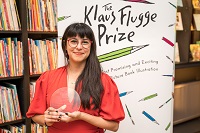 Marcus Duran
Marcus DuranThis article is in the Featured Author and Interviews Categories
Tickling Terror Tropes: an interview with Klaus Flugge Prize winner Flavia Z Drago
Mat Tobin, one of the judges of this year’s Klaus Flugge Prize, interviews 2021 winner Flavia Z Drago.
Flavia Zorrilla Drago’s prize-winning debut is a sweet marriage between two aspects of her childhood: the anxieties that came with making friends and a love for the horror genre. In Gustavo the Shy Ghost, our eponymous protagonist floats across the pages at a loss to understand how everyone in his community seems to just get along and talk to each other. How do they do it and what talent does our little ghost have that can help him feel seen?
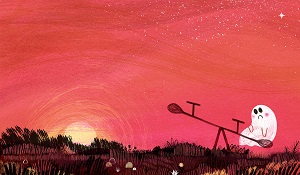 ‘When I started making the book, I didn’t notice how much I had in common with Gustavo, but the more I got to understand him, I realised that telling his story was important for me because I wanted to show that being shy doesn’t mean that you don’t enjoy the company of people – or in this case, monsters! – It just means that you find it difficult to reach out to others, especially for the first time.’
‘When I started making the book, I didn’t notice how much I had in common with Gustavo, but the more I got to understand him, I realised that telling his story was important for me because I wanted to show that being shy doesn’t mean that you don’t enjoy the company of people – or in this case, monsters! – It just means that you find it difficult to reach out to others, especially for the first time.’
Flavia soon realised that she was telling a story that echoed the uneasiness she felt when trying to connect with other children during her time at preschool. She had older siblings and loved playing with her cousins, but being at school and mixing in was different. And whilst Gustavo uses the haunting melodies of his violin as a calling card for friendship, for Flavia drawing became the way in which she could connect with others: their love for and celebration of the arts was key.
But playing the violin wasn’t a big enough challenge for Gustavo, recalls Flavia, ‘He needed to be extra brave in order to be seen and so this is why he organises a party’. For the creator, this was an ideal opportunity to bring together two of her favourite celebrations: Halloween and The Day of the Dead. Having spent her childhood in Mexico City, horror and all things spooky and spiritual were part and parcel of growing up. “My whole generation grew up watching horror films any time of the day, we had a channel dedicated to them.”
With Halloween, Flavia loved being able to dress up, wear silly makeup and get sweets with her cousins, and the Day of the Dead was a special and comforting way of remembering the loved ones who had died: a symbiotic relationship that readers young and old can enjoy finding within the pages of her book. From José Guadalupe Posada’s Katrina to Universal Picture’s Bride of Frankenstein, Gustavo’s world mirrors the creator’s own upbringing and she was delighted that Walker Books were keen for her to celebrate her own Mexican heritage and culture…with monsters!
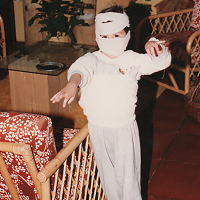 The authenticity of the Mexican vernacular throughout was something that delighted the judges too. From the buildings to the furniture and costumes, there was a sense here that Flavia was building upon her home and upbringing; bringing her childhood and sense of childness into the frame. As a dedication to The Day of the Dead and in remembrance of her grandparents, Flavia placed ofrendas, little altars, within the pages of the book, decorated with the deceased’s favourite things. In the graveyard scenes, she drew tombstones each carved with the name of her late grandparents. ‘In a way, my book is honouring the tradition and my loved ones at the same time.’ So for Flavia, horror is something she finds comfort in. If she wants to relax, she won’t watch comedy or chick-flicks: stories of divorce or unrequited love are far more distressing. Instead, the illustrator finds pleasure and comfort in the aesthetics of horror.
The authenticity of the Mexican vernacular throughout was something that delighted the judges too. From the buildings to the furniture and costumes, there was a sense here that Flavia was building upon her home and upbringing; bringing her childhood and sense of childness into the frame. As a dedication to The Day of the Dead and in remembrance of her grandparents, Flavia placed ofrendas, little altars, within the pages of the book, decorated with the deceased’s favourite things. In the graveyard scenes, she drew tombstones each carved with the name of her late grandparents. ‘In a way, my book is honouring the tradition and my loved ones at the same time.’ So for Flavia, horror is something she finds comfort in. If she wants to relax, she won’t watch comedy or chick-flicks: stories of divorce or unrequited love are far more distressing. Instead, the illustrator finds pleasure and comfort in the aesthetics of horror.
‘I’m not interested in shocking the audience.’ For Flavia, these icons from both her own Mexican culture and those from cinema are ones that can be fun and playful: something to delight in rather than fear, and this sensitivity seems to chime with her own cultural upbringing around death and family.
Much of horror in film plays on the concept of leaving spaces for the audience to imagine and interpret: What is that shadow? Who is that behind the curtain? Flavia, who completed her MA at the much-celebrated Anglia Ruskin University in Cambridge, noted that picturebooks worked in a similar way: let the pictures do the talking and peel back the written words so that the reader/beholder can find the space to bring their own interpretations.
Initially, Flavia approached the creation of picturebook stories by focusing on the written narrative first. She struggled to do this and found the process constricting and stressful. It was only when her lecturer, Professor Martin Salisbury, told her to switch her priorities and let the illustrations carry the weight of the stories that she suddenly found the picturebook process illuminating and liberating.
‘To know that I could think about my story in pictorial terms and then get the language to work for the images was a welcome realisation for me.’ Perhaps this goes some way to explain the creative freedom Flavia allowed herself when building Gustavo’s richly illustrative world; it was certainly something that the judges of the Klaus Flugge Prize revelled in.
It looks like Flavia’s future in children’s literature will go from strength to strength. With a pair of board books published: Monsters Play Peekaboo and Monsters Play Counting, we get to re-encounter the warm, friendly – if not decidedly ghoulish – characters from Gustavo. This time there is a greater emphasis on tactile play and interaction. ‘The idea is to just make monsters and their world really friendly for babies. You read the sounds the monster makes and have to guess what it is before lifting the flap.’
Meanwhile, Flavia has also begun her doctorate at Anglia Ruskin that continues her exploration of horror tropes in children’s illustration whilst simultaneously working on a new picturebook about witches. Whilst discussing her doctoral project, Flavia cited some of her favourite picturebooks that play around the fringes of horror: Nadia Shireen’s Good Little Wolf, Jon Klassen’s I Want My Hat Back and especially Tomi Ungerer’s Zeralda’s Ogre. ‘This book invites the reader to see that good and bad are not just simple concepts, things are more complicated. Always.’ In the story, the child-eating Ogre is tamed by his love for a young girl, Zeralda, and her culinary skills. Together they have several children and although the Orge may have changed his ways, one of their children, hiding a knife and fork in his hand whilst looking hungrily on at its baby sibling, invites a deeper, alternative reading.
What is implied then is in the eyes of the beholder and Flavia is interested in exploring those liminal spaces between what cultures deem scary or sweet and safe and dangerous. I have found interviewing Flavia inspiring and thought-provoking, and all the Klaus Flugge Prize judges were immensely pleased that Walker Books encouraged her to celebrate her love of these spaces alongside her Mexican heritage. Children’s literature that challenges societal and cultural norms are always welcome even when they involve ghosts, ghouls and bonnet-wearing calacas (skeletons).
Mathew Tobin is a Senior Lecturer in Primary English and Children’s Literature. His co-authored book, Teaching and Understanding Primary English, is published by Sage Publishing, 9781526426598, £24.99.
Gustavo the Shy Ghost is published by Walker Books.

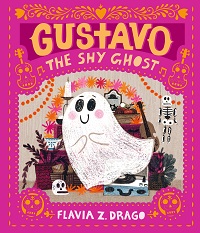
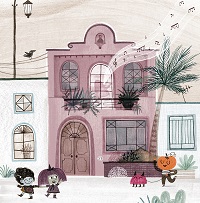

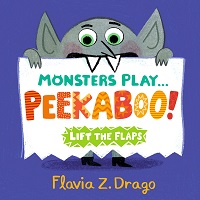
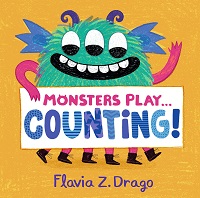



 Jennifer Lau
Jennifer Lau